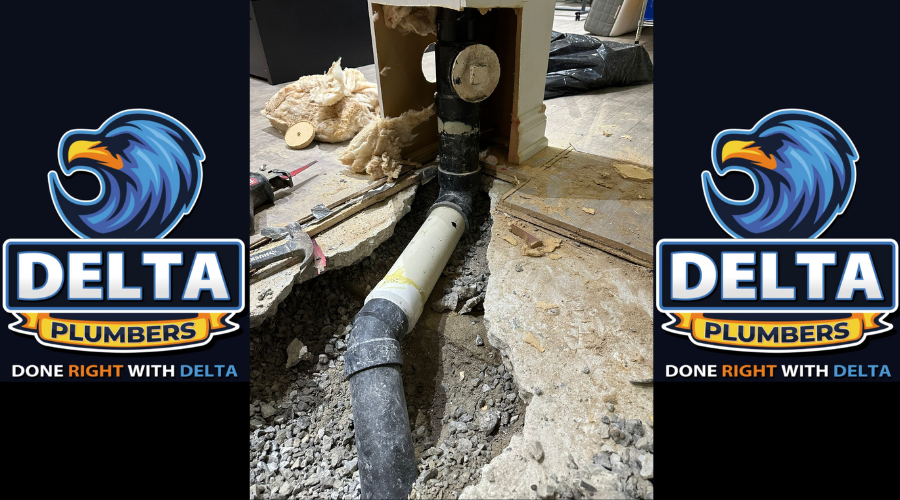Why Sewer Line Maintenance is Essential for Homeowners
Your home’s sewer line is one of the most critical systems in your plumbing network, responsible for transporting wastewater away from your property and into the municipal sewer or septic system. When it’s working properly, you likely don’t think much about it. However, when problems arise, they can cause serious damage, resulting in costly repairs, extensive property damage, and health hazards. By maintaining your sewer line, you can prevent problems before they become major issues, saving you money, time, and hassle in the long run. Regular sewer line maintenance can also help ensure your plumbing system is working efficiently, keeping your home’s water and waste disposal systems running smoothly. Let dive into this comprehensive guide on how to maintain your home’s sewer line and avoid costly repairs.

Picture Source – Delta Plumbers
Common Sewer Line Problems Homeowners Face
Sewer line problems can occur for various reasons. Understanding the common issues can help you identify problems early, potentially saving you from expensive repairs. Here are the most common sewer line problems that homeowners face:
Clogs and Blockages –
Over time, debris such as grease, food scraps, hair, soap, and other substances can build up in your sewer pipes, causing blockages. These clogs can prevent wastewater from properly flowing through the pipes, leading to backups and flooding.
Tree Root Intrusion –
Tree roots are naturally drawn to the moisture found in sewer pipes. If your sewer line has cracks or weak spots, roots can infiltrate, causing blockages, leaks, and even structural damage to the pipe itself.
Pipe Corrosion –
Pipes made from older materials like cast iron or galvanized steel can corrode over time. This corrosion leads to weakened pipes that are more susceptible to cracks, leaks, and eventual failure.
Cracks or Breaks in the Pipe –
Shifting soil, settling foundations, or external pressures can cause cracks or breaks in sewer pipes. Even small fractures can lead to significant damage if not addressed quickly.
Sewer Line Leaks –
Sewer lines are under constant pressure, and over time, they can develop leaks. Even minor leaks can allow waste and wastewater to seep into your yard or foundation, causing water damage and attracting pests.
Also Read: Water Heater Repair vs. Replacement: How to Decide What’s Best for Your Home

Picture Source – Delta Plumbers
Signs You Need to Inspect Your Sewer Line
Regularly checking your sewer line for issues can prevent small problems from escalating into larger, more expensive repairs. Here are some key signs that indicate it’s time to schedule a professional sewer line inspection:
Slow Drains –
If you notice that multiple drains in your home are slow to empty, it could be a sign of a clog or blockages in the sewer line.
Frequent Clogs –
If you are dealing with frequent clogs in your kitchen or bathroom drains, even after you’ve cleared them, your sewer line could be partially obstructed, causing water to back up.
Unpleasant Odors –
Foul odors emanating from drains or the yard near the sewer cleanout often point to problems within the sewer line. These odors could be from trapped waste, debris, or gas buildup.
Pooling Water in Your Yard –
If you notice pooling water or soggy spots in your yard, especially near your sewer line or cleanout, this may indicate a break or leak in the pipe.
Multiple Drain Issues –
If your toilet, shower, and kitchen sink are all experiencing problems at the same time, it’s a strong indicator that something is wrong with your main sewer line.
Also Read: Trenchless Sewer Repair: The Future of Sewer Line Replacement Without Digging

Picture Source – Delta Plumbers
How to Perform Basic Sewer Line Maintenance
Maintaining your sewer line doesn’t have to be difficult, and it’s an essential part of extending the life of your plumbing system. Here are some simple steps you can take to maintain your sewer line and prevent future issues:
Regular Drain Cleaning –
Use a professional drain cleaning service at least once a year to remove debris buildup in your pipes. This will help maintain water flow and prevent blockages.
Avoid Chemical Drain Cleaners –
Chemical drain cleaners can be harmful to your pipes and the environment. Instead, opt for natural cleaning methods or professional cleaning services.
Install Drain Screens –
Place screens or catchers in your sinks, tubs, and showers to trap hair, grease, and other debris before they enter your drain system.
Proper Disposal of Grease and Debris –
Never pour grease, oil, or large food scraps down the drain. Dispose of them properly by throwing them away or recycling them.
Also Read: How to Prevent Basement Flooding in Ontario This Spring

Picture Source – Delta Plumbers
Professional Sewer Line Inspections: What to Expect
While basic maintenance can go a long way in preventing sewer line issues, nothing beats a professional inspection when it comes to identifying hidden problems in your pipes. Here’s what you can expect during a professional sewer line inspection:
What is a Sewer Line Inspection?
A sewer line inspection involves using specialized equipment, such as a camera attached to a flexible cable, to inspect the inside of your pipes. The camera sends real-time footage to a monitor, allowing plumbers to identify blockages, cracks, tree root intrusion, or other issues.
Why Hire a Professional?
Sewer line inspections require specialized equipment and expertise. A professional plumber can accurately assess the condition of your sewer line and recommend the best course of action. Attempting to inspect your sewer line without the proper tools can result in inaccurate diagnoses or further damage.
The Process of Sewer Line Inspection
During an inspection, the plumber will insert a camera into the sewer line via the cleanout or a drain. The camera moves through the pipe, capturing high-definition footage that allows the plumber to identify any issues. The plumber may also perform a pressure test to check for leaks.
How Often Should You Schedule Inspections?
It’s recommended to have a professional sewer line inspection at least once every two years, especially if your home is older, you’ve experienced drainage issues, or if you have large trees near your sewer lines. Regular inspections help catch issues early before they become costly problems.
Also Read: Spring Plumbing Maintenance Tips for Ontario Homeowners

Picture Source – Delta Plumbers
The Benefits of Regular Sewer Line Maintenance
Regular sewer line maintenance offers several advantages that can help homeowners save money and avoid the hassle of major plumbing issues. Here are some of the key benefits of keeping your sewer line in top condition:
Prevention of Costly Repairs –
One of the most significant benefits of regular maintenance is the prevention of costly repairs. Addressing small issues before they escalate into larger problems can save you thousands of dollars in repair and replacement costs.
Improved Plumbing Efficiency –
A well-maintained sewer line ensures that wastewater flows efficiently through the pipes without obstruction. This helps your entire plumbing system operate more smoothly, reducing the chances of clogging, backups, and other plumbing-related problems.
Increased Property Value –
Properly maintaining your sewer line can also increase your home’s value. Potential buyers will appreciate knowing that the plumbing system is in good condition, which can be a key selling point for your property.
Avoidance of Health Risks –
A malfunctioning sewer line can result in the backup of raw sewage into your home, posing significant health risks. Regular inspections and maintenance can help prevent these health hazards by ensuring that your sewer system operates as intended, protecting your family’s health and safety.
Also Read: The Rising Cost of Plumbing Repairs in 2025: What Homeowners Need to Know

Picture Source – Delta Plumbers
How to Prevent Tree Root Invasion in Your Sewer Line
Tree roots are one of the most common culprits behind sewer line damage. Tree roots naturally seek out water sources, and your sewer pipes offer a consistent water supply. Here’s how to prevent tree roots from invading your sewer line and causing expensive repairs:
Tree Root Barriers –
Installing a tree root barrier along your sewer line can prevent roots from growing into your pipes. These barriers are typically made of materials like plastic or metal and create an impenetrable shield around the pipes.
Choosing the Right Trees for Your Yard –
When planting trees near your home, avoid species with aggressive root systems. Trees like willows, oaks, and maples have roots that are more likely to invade sewer lines. Instead, opt for trees with smaller, less invasive root systems.
Regularly Trimming Roots Near the Sewer Line –
If you have large trees near your sewer line, it’s important to trim the roots periodically. This prevents them from growing too close to the pipe and causing damage. If you notice roots encroaching on the sewer line, hire a professional to safely remove them.
Consider Pipe Lining or Replacement –
If tree roots have already invaded your sewer line, pipe lining or replacement may be necessary. Pipe lining involves inserting a new liner inside the existing pipe to create a smooth, root-resistant surface. In more severe cases, full pipe replacement may be required.
Also Read: Smart Plumbing Solutions: How Technology is Changing Home Water Systems in 2025

Picture Source – Delta Plumbers
How to Fix a Broken Sewer Line and When to Call a Plumber
If you notice that your sewer line is broken or malfunctioning, it’s important to take quick action. While some minor problems can be fixed on your own, many sewer line issues require professional assistance. Here’s what to do if you think you have a broken sewer line:
Temporary Solutions for Small Leaks –
For small leaks or minor cracks in your sewer line, there are temporary solutions you can try, such as using pipe repair tape or applying a waterproof sealant. However, these are only temporary fixes and should not replace professional repairs.
When DIY Isn’t Enough –
DIY repairs are not recommended for larger issues like a severely broken or collapsed sewer line. Sewer lines are complex systems that require specialized tools and expertise to fix properly. Attempting to repair a broken sewer line yourself could cause more harm than good.
The Cost of Sewer Line Repair or Replacement –
The cost of repairing or replacing a sewer line depends on the severity of the damage, the type of material used for the pipes, and the complexity of the job. For example, tree root removal or pipe replacement can cost thousands of dollars. It’s important to weigh the costs of repairs against the long-term benefits of a properly functioning sewer system.
The Role of Professional Plumbers in Sewer Line Repair –
Professional plumbers are equipped with the knowledge and tools needed to assess and repair your sewer line quickly and efficiently. They may use techniques like trenchless repair methods, which minimize the disruption to your yard and reduce the cost of repairs.
Conclusion –
Maintaining your sewer line is an essential part of keeping your home’s plumbing system functioning properly. Regular inspections, early detection of issues, and proactive maintenance can prevent costly repairs and ensure your home’s plumbing system remains in top condition. Don’t wait for a sewer line emergency to catch you off guard—schedule regular inspections, avoid damaging practices, and work with professional plumbers to ensure the longevity of your sewer line. By staying on top of maintenance, you’ll protect your home from the inconvenience, expense, and health risks associated with neglected sewer systems.









